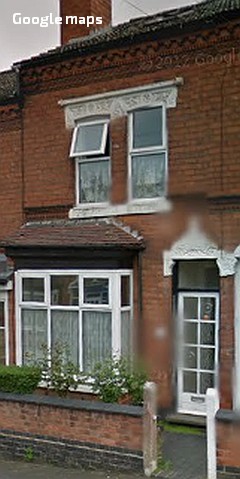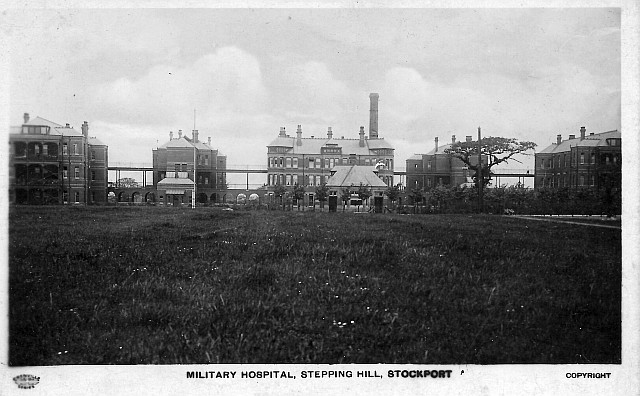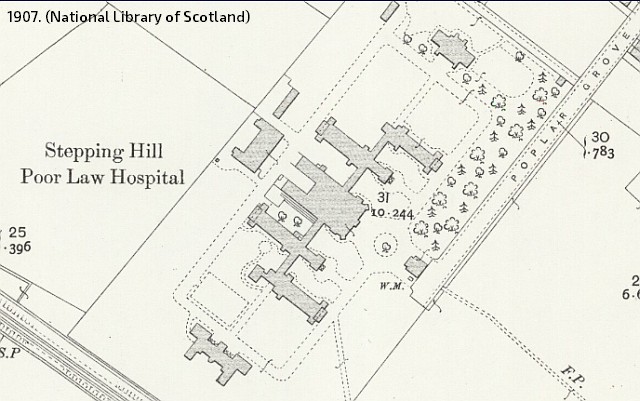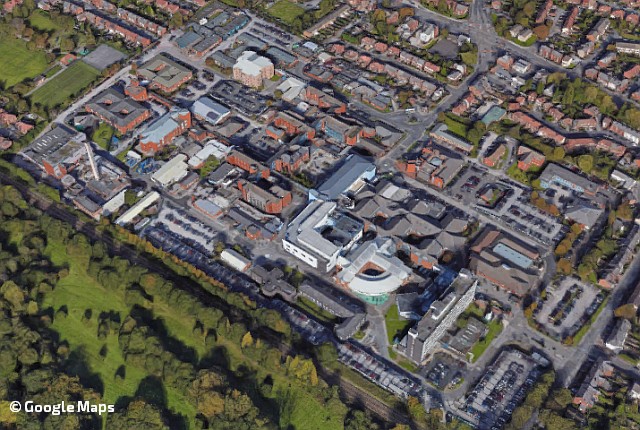Davenport Station home | Index to History pages
This postcard was sent in 1916 by T.J. Jones to Miss M. Thompson (probably a work colleague) in Birmingham.
The text reads:
Pte T.J. Jones, RAMC 78985. Ward A1, Thursday.
Dear Lil, Just a line in answer to your kind & welcome
letter which I received back from the desert this morning.
I am pleased to say I am going on very nicely thanks to
nurses & Sister also doctors. Also I must say the
Sister we had in ward B1 was an angel as kind and good to
all us boys. Well Lil, I don't know when I shall be coming
out, but when I do I shall come and see you all at the
works [...] Yours etc. Pte T.J. Jones
Family history
We have been able to trace Private Thomas James Jones using internet resources. Born in Llandewey, Radnorshire, on 20 July 1884, the 1911 census lists him living at 12 Regent Street, Stirchley, near Birmingham. He married Stirchley-born Daisy Florence Morse, and by 1911 had sons Eric Edward Jones (ages 1) and Cecil Morse Jones (4 months). Living with them was a widowed great-aunt, Priscilla Green.
Thomas was working as a warehouseman for a cocoa & chocolate manufacturer, undoubtedly the famous Cadbury company whose Bournville works is a short walk from Regent Street.
He joined the Royal Army Medical Corps in 1915 and was sent to Egypt which at the time was a British colony, and had many army camps and hospitals. RAMC soldiers were 'non-combatants'. Some of them came from the ranks of Conscientious Objectors, although Mr Jones joined the army in 1915 before military service was made compulsory.
Privates would fill roles, often in dangerous positions, such as stretcher bearers and other activities not requiring medical qualifications.

He returned after the war to 12 Regent Street and his job at the Cadbury factory; in 1939 he was a stockroom orderman, and during World War II he additionally acted as an Air Raid Precautions (ARP) warden.
Regent Street is one of a group of three (the others are Bond Street, Oxford Street) built around 1900 by the Grant Estate. No.12 still exists in 2002; a feature unusual in such terraced housing is that each house was built with an individual name, in a decorative plaster moulding above the door, which has unfortunately been obscured by Google.
He died in 1946, and is commemorated at Lodge Hill cemetery in Birmingham along with his wife Daisy who died in 1959.
References
Stockport Workhouse page by Peter Higginbottom
Stockport NHS Website
Ancestry.co.uk
British Newspaper Archive
National Library of Scotland Maps
Google Maps
Stirchley Walking Trail
Wikipedia 'Workhouse'
Comments welcome at info@davenportstation.org.uk

This postcard was published by prolific Stockport firm 'Grenville Series', using the photograph from an existing card which was captioned 'Stepping Hill Hospital, Stockport'. The view is from Bramhall Moor Lane near what is now the main entrance gate of the expanded hospital.
The hospital, which today is the principal hospital for Stockport and the High Peak area, opened in 1905 as the Stepping Hill Poor Law Hospital, by the Stockport Poor Law Union, responsible for the Stockport Workhouse in Shaw Heath. 'Poor Laws' requiring citizens to fund facilities for the poor and destitute, had been in force in various forms since the 1500s, and the Workhouse was one of the answers. Initially paupers who were sick or giving birth were treated in an makeshift infirmary at Workhouse, but by 1900 it was realised a purpose-built facility was more appropriate.
The Workhouse in Shaw Heath, the oldest part of which dated from 1842 later became a geriatric hospital called St Thomas's, which housed elderly patients re-located from Stepping Hill while it was decided whether they could safely go home. (The author's mother spent several unhappy weeks in there.) It finally closed in 2004; in 2020 the (listed) buildings still stand empty.The site chosen for the new infirmary was an area of farmland, formerly part of the Bramhall estates of the Davenport family, between the Stockport - Buxton Road and the London and North Western Railway's Stockport - Buxton railway in an area known as Stepping Hill. A railway siding was provided, presumably for the delivery of building materials and later coal for the boilers, but by 1914 fell into disuse was removed. The original buildings occupied a rectangular site served by a new street called Poplar Grove, but large areas either side were protected for future use.
In its original form, the hospital comprised a central administration block including a boiler house, flanked by two three-storey pavilions ( with 24 beds on each floor) either side, linked by walkways which were open to the air, presumably to protect against cross-infections. Nearby was residential accommodation for staff.
The Official Opening
Manchester Courier and Lancashire General Advertiser - Saturday 9 December 1905:
Mr. G. N. Andrew, chairman of the Stockport Board of Guardians, on Thursday, in the presence of a large gathering, including representatives from many local and district authorities, formally opened the new workhouse infirmary at Stepping Hill, which will afford accommodation for three hundred and forty patients, a home for thirty-six nurses, and housing for twenty-four officials and servants. The administrative block and a large waiting hall occupy the central position: there are on each side of the main corridor two pavilions, each for men and women, having three floors, and at the end exercise verandahs and escape staircases. The entire equipment is of an up-to-date character, and the cost is estimated £130 per bed. A gold key for the opening ceremony was presented to Mr. Andrew by the architect, Mr. W. H. Ward, Birmingham. During the afternoon a large number of visitors were shown over the building by members of [the] Board.

Above, the initial layout of the hospital from an Ordnance Survey.
The 1914-18 war saw the hospital assume the role of a Military Hospital, along with several other buildings in Stockport, although some of the wards were probably retained for public use.
In 1930 the workhouse system was abolished, and Stepping Hill was taken over by Stockport Council and renamed as a 'Public Assistance Institution' although the old name remained in common use. In 1948, it passed to the National Health Service to become Stepping Hill hospital. The Stockport Infirmary in the town centre, which had been built in the 1830s as a charitable institution and also became part of the National Health Service until 1996 when it was closed, to become part of an office complex. Stepping Hill, which had by then expanded to fill all the available space on either side of the original rectangular plot, became the General Hospital for a wide area, part of Stockport Hospital Foundation Trust.

The hospital in 2020. Surviving original buildings can be seen in the centre of the view. The railway runs from middle left to bottom right of the image; in the 198os there was a proposal for a station to serve the hospital, but this never materialise, but visitors and staff can make a 10-minute walk from Woodsmoor station, opened in 1990.
The Autograph Book
Mary Hicks, who was a nurse at the hospital at the time, kept an autograph book in which patients could leave messages, drawings, or other thoughts. After being lost for many years, the book was discovered in Cornwall in 2014, and returned to Mary's family. A digital copy was made and is available to browse on the Hospital's website. One of the many contributors was none other than Thomas J. Jones, who wrote (page 6):
To Our Nurse
For those who minister and heal,
And spend themselves, their skill, their zeal,
Renew their hearts with Christ-like faith,
And guard them from disease and death.
And in thine own good time Lord, send
Thy Peace on earth till time shall end!
Pte Thomas J. Jones
26th C.C. Station
Stepping Hill Military Hospital
June 17th/16.
(The quotation is the final verse of 'Hymn for the Men at the Front' by John Oxenham, pen-name of Manchester-born journalist, novelist and poet William Arthur Dunkerley, which was widely distributed in postcard form.)
Written by Charlie Hulme, April 2020, in tribute to all at the NHS and thanks to the staff at Stepping Hill for being there to care for myself and my family when needed.